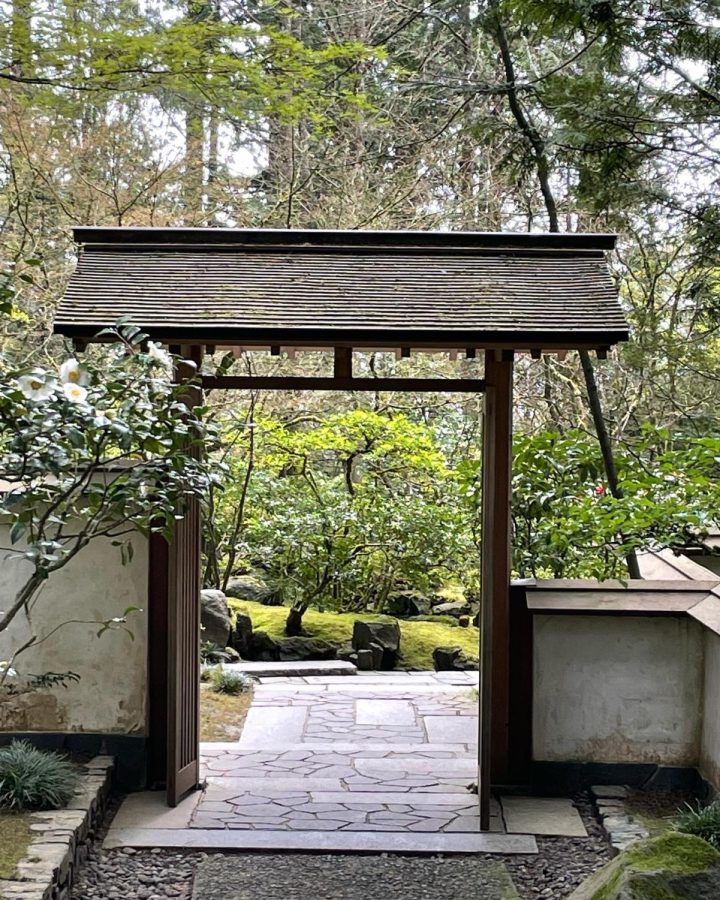photo courtesy of Katherine Nolan
Breathing Fresh Air at Portland Japanese Garden
June 1, 2022
Photographs by Erin Picken.
Japanese gardens outside of Japan are seen not only for their beautiful aesthetic, but also for the connection they lend to both nature and Japan. Unlike many western gardens, Japanese gardens aspire to present the idealized form of the vegetation of the gardens’ natural surroundings. According to Shiro Nakane, president of Nakane & Associates, “the Japanese have possessed a tradition to live symbiotically with nature, and their gardens and surrounding nature included exactly the same vegetation and landscape.”
In the 1996 International Symposium of Japanese Gardens, David Slawson described the two categories under which Japanese gardens outside of Japan are made: the ‘higher’ path and the ‘lower’ path. Slawson classified Japanese gardens that use lanterns, water basins, ponds and water lilies as gardens as following a ‘low’ path. These gardens merely mimic classic Japanese elements and miss the spirit of Japanese gardens. Slawson argued that “creativity is rigidly constrained by external norms which favor the status quo” in this type of garden. Slawson stated that the ‘higher’ path is sensitive to the location of the garden. Slawson’s definition of gardens made from the ‘higher’ path agrees with Nakane’s statement that Japanese gardens offer a connection to nature and the gardens’ natural surroundings.
The Portland Japanese Garden was created to materialize the growing ties between Oregon and Japan. The idea of the garden was first conceived in the 1950s by Mayor Terry Schrunk to heal wounds with Japan following World War II. During this time, many Japanese gardens were founded in the United States for the same reason. In 1967, the Portland Japanese Garden opened as a place to build cultural understanding without needing a translation.

Sand and Stone Garden
Sand and stone (karesansui) gardens are a type of garden unique to the Japanese. These gardens are simplistic and have few distractions; they feature exclusively stones of various forms. However, water is represented by small, raked pebbles, and the large rocks represent mountains. In the sand and stone garden pictured, ripples can be seen in the raked pebbles.

Flat Garden
Flat (hira-niwa) gardens are an expansion on stone (karesansui) gardens. This type of garden has more subjects than the sand and stone gardens, but it still features pebbles prominently. These gardens are designed to be viewed from a single axis along a veranda that allows viewers to see the depth in perspective created by the raked rocks, shrubs and trees in the background.

Strolling Pond Garden
Strolling pond (chisen kaiyu shiki teien) gardens are intended to be observed from within the garden. Occasionally, these gardens are designed to mimic the natural landscape of another place. Interestingly, the strolling pond garden in Portland is imitating the landscape of Japan—the origin of this style of garden. These gardens are an evolution of an older style of garden where the pond garden was observed from small boats within the pond.

Natural Garden
The natural garden at the Portland Japanese Garden was designed using the philosophies of old Japanese gardens in a new context. Japanese gardens were first designed as idealized expressions of the natural environment, so the natural garden at the Portland Japanese Garden features the vine maple—a plant indigenous to the pacific northwest.

Tea Garden
Tea (cha-niwa) gardens are a type of garden designed for quiet reflection and harmony. These gardens are designed so that people can detach themselves from their everyday life. In this type of garden, people first enter the soto-roji path and walk through the forest to the waiting place between the soto-roji and roji. Before walking to the tea house through the roji path, people wash their hands in the water basin to symbolically cleanse themselves of the outside world.
This piece was originally published in Inkwell’s Portland Issue.
